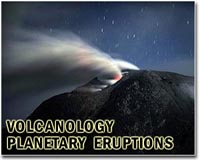| . |  |
. |
Mount Merapi, Indonesia (AFP) Oct 25, 2010 Indonesia ordered thousands of people to evacuate from around Mount Merapi on Monday as it raised the alert for its most active volcano to red, warning of a possible imminent eruption. Seismic activity has escalated dramatically at the volcano on the densely populated island of Java, with increasing lava spurts and about 500 multi-phased volcanic earthquakes recorded over the weekend, officials said. The state office of volcanology had upgraded its alert level to red at 6:00 am (2300 GMT), signalling an eruption could be imminent. "The magma has been pushed upwards due to the escalating seismic energy and it's about a kilometre (mile) below the crater," government volcanologist Surono said. About 19,000 residents have been ordered to evacuate a danger zone of 10 kilometres (six miles) from the crater of the 2,914-metre (9,616-foot) mountain. About 3,000 have already moved to makeshift camps, officials said. "The evacuation has been under way since this morning. We put a priority on children, women and elderly," field coordinator Widi Sutikno of the main Sleman district on the southern slopes of the mountain told AFP. Merapi -- whose name means "Mountain of Fire" -- has been blanketed with clouds since the morning. Local resident Yanto, 38, said he would remain in his village to tend his sheep. "I haven't seen any visible threats from Merapi. It is better for young men like me to stay here to look after our livestock. If the volcano does erupt, we can escape quickly," he told AFP. "Let the children and old people go first to a safer place," he added. Central Java Governor Bibit Waluyo called for residents to stay calm. "Procedures are in place to deal with the disaster if it happens so people need not panic," he was quoted as saying by Antara state news agency. The volcano is the most active of 69 volcanoes with histories of eruptions in Indonesia, which straddles major seismic fault lines in a region known as the "Pacific Ring of Fire". The archipelago has more active volcanoes than any other country. Mount Merapi, which lies around 25 kilometres north of the town of Yogyakarta in the centre of Java, last erupted in June 2006 killing two people. Its deadliest eruption occurred in 1930 when more than 1,300 people were killed. Heat clouds from another eruption in 1994 killed more than 60 people. "It currently has more energy than before the 2006 eruption. We haven't found strong indications that it will erupt explosively as it did in 1930 but there is still a possibility," Surono said. In August, the 2,460-metre (8,100 foot) Mount Sinabung on the island of Sumatra erupted for the first time in 400 years, sending thousands of people into temporary shelters and disrupting flights. Mount Sinabung is near Lake Toba, a 100-kilometre long volcanic crater that some archaeologists believe almost wiped out the human race when it erupted 69,000-77,000 years ago.
Share This Article With Planet Earth
Related Links Bringing Order To A World Of Disasters When the Earth Quakes A world of storm and tempest
 Indonesia orders evacuations as volcano threat peaks
Indonesia orders evacuations as volcano threat peaksYogyakarta, Indonesia (AFP) Oct 25, 2010 Indonesia raised its alert for Mount Merapi to its highest level on Monday and ordered people living near the rumbling volcano to move immediately to safer ground. Seismic activity has escalated dramatically at the volcano on the densely populated island of Java, with increasing lava spurts and about 500 multi-phased volcanic earthquakes recorded over the weekend, officials said. The sta ... read more |
|
| The content herein, unless otherwise known to be public domain, are Copyright 1995-2010 - SpaceDaily. AFP and UPI Wire Stories are copyright Agence France-Presse and United Press International. ESA Portal Reports are copyright European Space Agency. All NASA sourced material is public domain. Additional copyrights may apply in whole or part to other bona fide parties. Advertising does not imply endorsement,agreement or approval of any opinions, statements or information provided by SpaceDaily on any Web page published or hosted by SpaceDaily. Privacy Statement |